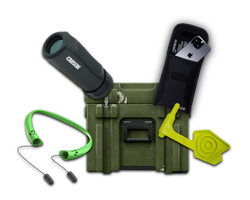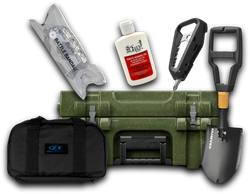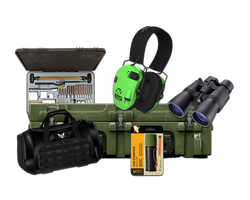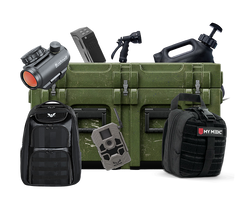How to Make Moving Targets for Shooting: A Comprehensive Guide
Table of Contents
- Introduction
- The Importance of Moving Targets in Shooting Practice
- Different Types of Moving Targets You Can Create
- Materials and Tools Needed for Construction
- Step-by-Step Instructions to Build Your Own Moving Target
- Safety Considerations When Using Moving Targets
- Integrating Moving Targets into Your Training Routine
- Conclusion
- FAQ Section
Introduction
Imagine standing at the shooting range, your heart racing as you prepare to take aim. Instead of the usual stationary targets, you’re faced with something dynamic and challenging: a moving target. This is not just a thrilling change of pace; it’s also an invaluable tool for improving your shooting skills. But how do you create these moving targets?
In this extensive guide, we will explore the methods and materials needed to construct your own moving targets for shooting. Whether you are a seasoned shooter looking to enhance your skills or a beginner wanting to practice in a more engaging way, this article will provide you with the information you need. By the end of this post, you will not only know how to make moving targets but also understand their significance in shooting practice and the various options available for different skill levels and budgets.
We will cover several aspects:
- The importance of moving targets in shooting practice
- Different types of moving targets you can create
- Materials and tools needed for construction
- Step-by-step instructions on how to build your own moving target
- Safety considerations when using moving targets
- Recommendations for integrating moving targets into your training routine
So, let’s dive into the exciting world of moving targets and discover how you can make your shooting practice more effective and enjoyable!
The Importance of Moving Targets in Shooting Practice
Shooting at moving targets enhances your skills in several ways. Unlike stationary targets, moving ones require shooters to adjust their aim dynamically, improving their hand-eye coordination, reaction time, and overall shooting accuracy. Here are some key benefits:
Enhances Shooting Skills
- Improved Accuracy: Shooting at moving targets helps shooters learn to lead their shots, which is crucial for hitting fast-moving objects in real-life scenarios, such as hunting or self-defense situations.
- Better Timing: It teaches shooters to time their shots, factoring in the speed and direction of both the target and the projectile.
- Increased Focus: Moving targets require sustained concentration, honing a shooter's ability to maintain focus under pressure.
Realistic Training
In real-life situations, targets are rarely stationary. Incorporating moving targets into your training routine prepares you for real-world challenges, making your practice more relevant and beneficial.
Fun and Engaging
Let’s face it: shooting at moving targets is significantly more exciting than standard paper targets. It adds an element of fun to your practice sessions, keeping you motivated and engaged.
Different Types of Moving Targets You Can Create
There are various types of moving targets you can make, each with distinct mechanics and complexities. Here’s a breakdown of some popular options:
1. Pulley System Targets
A simple yet effective method is to use a pulley system that allows you to manually move a target back and forth. This approach is cost-effective and great for beginners.
2. Electric Motorized Targets
For a more advanced option, consider using an electric motor to automate the movement of your target. This setup can provide variable speed and direction, making it more unpredictable and challenging.
3. Remote-Controlled Targets
Remote-controlled targets add an additional layer of excitement, allowing shooters to control the movement of the target from a distance. This option is ideal for those who enjoy a tech-savvy approach to shooting practice.
4. Rail Systems
Building a rail system allows the target to slide along a fixed track, simulating a more realistic movement pattern. This is a more permanent solution and requires more materials and construction skills.
5. Ground Cable Systems
Using a ground cable to pull the target side to side can be a practical and simple solution, allowing for smooth movement without complex mechanisms.
Materials and Tools Needed for Construction
Before you can build your moving target, you’ll need to gather the necessary materials and tools. Below is a comprehensive list based on the type of moving target you decide to construct.
Essential Materials
- Target Board: Use durable materials such as wood or metal for constructing the target itself.
- Pulleys: If using a pulley system, you’ll need small pulleys to facilitate movement.
- Cable or Rope: A strong cable or rope will be essential for moving the target.
- Support Structure: This can be made from wood or metal piping to create the framework for your target setup.
- Electric Motor: For electric or remote-controlled targets, you’ll need a suitable motor.
- Battery or Power Source: If utilizing electric components, ensure you have a reliable power source.
Tools Required
- Drill: For making holes and fastening components together.
- Saw: If you need to cut wood or metal to size.
- Wrenches/Screwdrivers: For assembling your target system.
- Measuring Tape: To ensure accurate dimensions of your target and supporting structures.
Step-by-Step Instructions to Build Your Own Moving Target
Building a Simple Pulley System Moving Target
-
Prepare the Frame: Construct a frame using wooden posts that will support the pulley system. The height should be adequate to allow the target to move freely.
-
Install Pulleys: Attach pulleys to the top of your frame. Ensure they are evenly spaced and aligned for smooth movement.
-
Install the Cable: Run a strong cable through the pulleys, ensuring it is taut but not overly tight.
-
Attach the Target Board: Cut a piece of wood or metal for the target. Use eye screws or similar hardware to attach it to the pulley system.
-
Create the Pulling Mechanism: Attach a string to the end of your target board. This string should run through additional eye screws positioned on the frame to allow for easy pulling.
-
Test the Mechanism: Pull the string to move the target back and forth. Adjust as necessary to ensure smooth operation.
Building an Electric Motorized Target
-
Build the Frame: Similar to the pulley system, construct a sturdy frame to house your target.
-
Install Rails: If using a rail system, attach a metal rail or a sturdy wooden track that the target will slide on.
-
Mount the Electric Motor: Secure the motor at one end of the rails. Ensure it is properly connected to a power source.
-
Connect the Target: Attach the target board to a movable platform that can slide along the rails. Connect the platform to the motor using a cable or chain.
-
Add Controls: Set up a remote control or switch to operate the motor, allowing for variable speed and direction.
-
Test and Adjust: Power on the motor and test the movement of the target. Make adjustments to the speed and range of motion as required.
Safety Considerations When Using Moving Targets
Safety should always be your top priority when engaging in shooting practice. Here are some essential tips to ensure a safe experience with moving targets:
- Use a Safe Backstop: Ensure that your shooting area has a safe backstop to catch any stray shots.
- Wear Appropriate Safety Gear: Always wear eye and ear protection while shooting.
- Establish a Clear Shooting Line: Make sure all shooters are aware of the designated shooting line and are positioned safely.
- Never Shoot at Unsecured Targets: Ensure that all moving targets are secured properly to prevent them from falling or moving unexpectedly.
- Conduct Regular Maintenance: Regularly check the integrity of your moving target systems to ensure they are safe to use.
Integrating Moving Targets into Your Training Routine
Once you’ve constructed your moving target system, it’s time to integrate it into your training routine. Here are some practical tips:
- Start Slow: Begin with slower movements to build confidence and accuracy before progressing to faster targets.
- Variety is Key: Mix up the movements and challenges offered by the moving targets to keep your practice sessions engaging.
- Incorporate Different Firearms: Use various firearms to experience how different weapons handle when shooting at moving targets.
- Track Your Progress: Keep a log of your shooting accuracy and improvement over time to stay motivated and focused on your goals.
Conclusion
Building moving targets for shooting not only enhances your shooting practice but also adds an element of excitement and challenge. By following the detailed guide provided above, you can create your own moving target system that suits your skill level and budget.
Whether you choose a simple pulley system or a more advanced motorized setup, the benefits of practicing with moving targets are undeniable. You will sharpen your shooting skills, improve your focus, and enjoy a more dynamic shooting experience.
As you embark on this journey, remember that safety is paramount. Always prioritize safety measures to ensure a secure practice environment. With the right tools, materials, and mindset, you’re well on your way to becoming a more proficient shooter.
For those looking to elevate their tactical gear and preparedness, consider exploring Crate Club’s subscription services. With a variety of options tailored to different skill levels and interests, you can equip yourself with high-quality gear to enhance your training experience. Learn more about our subscriptions here and browse our extensive collection of tactical products in the Crate Club Shop.
FAQ Section
1. What materials do I need to build a moving target?
You will need a target board, pulleys, cable or rope, a support structure, and possibly an electric motor if you are going for a motorized option.
2. How much does it cost to build a moving target?
Costs can vary widely depending on the materials used and the complexity of the target system. A simple pulley system can be built for under $50, while motorized systems may cost several hundred dollars.
3. Are moving targets safe to use?
Yes, as long as proper safety precautions are followed, moving targets can be used safely. Ensure you have a good backstop, use safety gear, and maintain your equipment regularly.
4. How can I integrate moving targets into my training?
Start by practicing with slower movements, mix up the challenges, and incorporate different firearms to improve your skills.
5. Can I use remote-controlled targets?
Absolutely! Remote-controlled targets provide an exciting way to practice shooting and can be adjusted to move unpredictably.
By understanding how to make moving targets for shooting, you’re taking a significant step toward enhancing your shooting skills and making your practice sessions more enjoyable. Happy shooting!
Share this article



